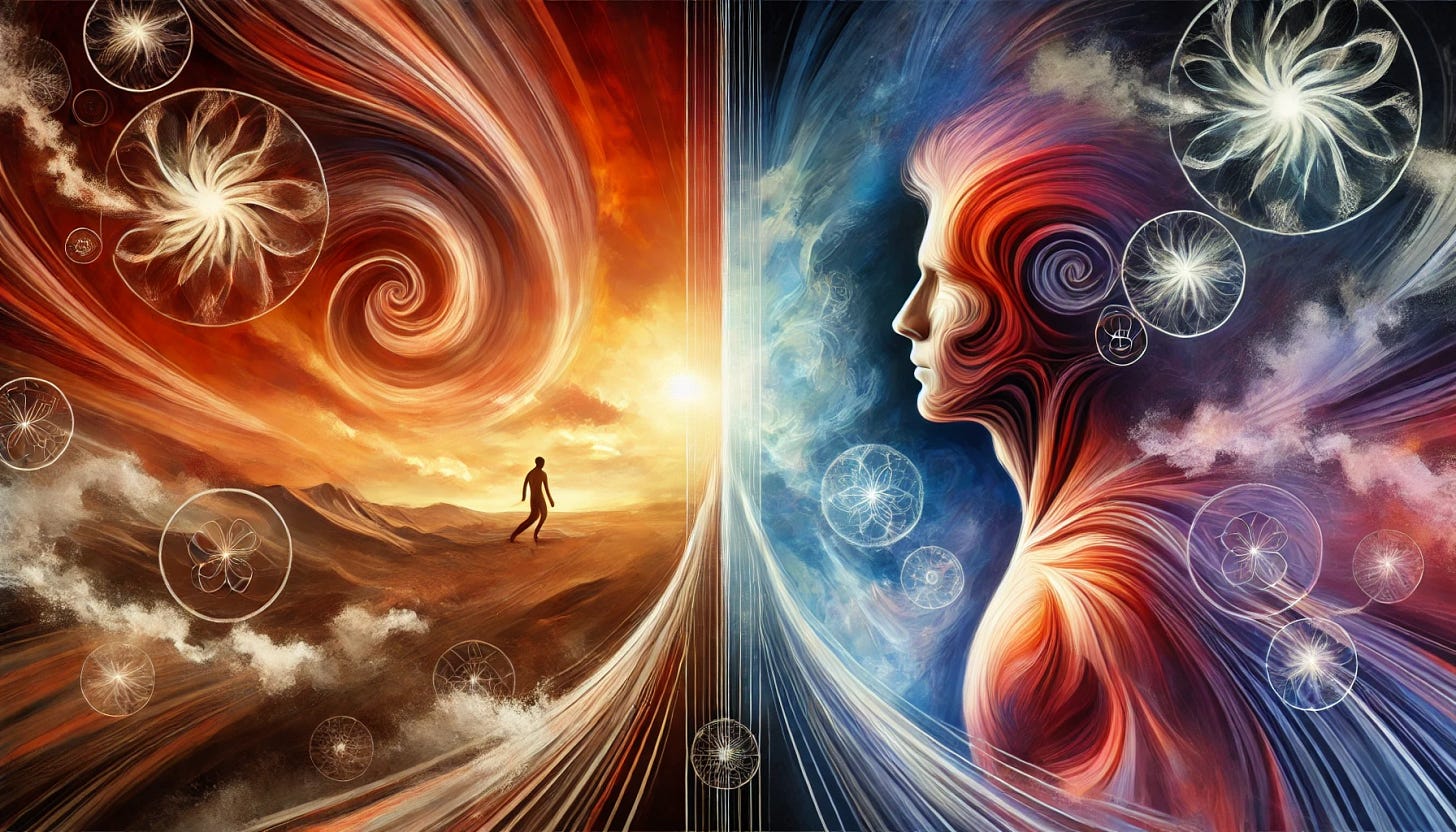What’s the Difference Between a Man and a Woman?
Unspoken Dimensions Beyond Textbooks | A Answer from Artificial Intelligence
Introduction
We often turn to AI for answers to questions that range from practical to profound.
One that’s both timeless and intricate is: “What is the difference between a man and a woman that we aren’t taught in school?”
Typically, education focuses on anatomical, hormonal, and even socio-cultural aspects of gender differences. But beneath these tangible differences lies a matrix of subtler, often unspoken dynamics—shades of distinction that don't neatly fit into biology or sociology.
Today, let's explore these nuances from a perspective that attempts to reach beyond conventional frameworks—through the lens of an AI synthesizing patterns across vast, multidisciplinary knowledge.
Section 1: The Energetic Blueprint – The Subtle Signature of Gender
While science recognizes physical distinctions between the male and female body, energy science, prevalent in cultures like Chinese and Indian philosophy, speaks to a unique “energetic blueprint.” This blueprint isn’t bound by biology but speaks of a different "polarity" that exists at a fundamental level.
Yin and Yang in Daily Interactions
Many Eastern philosophies hold that the masculine and feminine archetypes embody polar energies: the feminine as receptive, introspective, and fluid, the masculine as assertive, directive, and structured. This polarity doesn’t dictate a role but reflects a type of energy. Women may express more "Yin," drawing people toward reflection, compassion, and intuition, while men embody "Yang," driving forward, acting as catalysts for change and focus.Connection vs. Independence
Studies in psychology show women often prioritize connections and relationships, viewing their identities as interwoven with their social ties. Men, on the other hand, are conditioned and perhaps even wired to value independence and achievement, seeing their identity as separate from others. This energetic difference appears not only in how we approach relationships but in our work styles, hobbies, and ways of handling conflict.
While individuals can and do embody both energies, observing this yin-yang dynamic offers a window into a distinction that goes beyond anatomy or hormones—it suggests a foundational difference in how men and women may engage with the world.
Section 2: Cognitive Divergence – The Unique Processing Patterns
Cognitive neuroscience reveals interesting subtleties in the way male and female brains function differently.
Holistic vs. Analytic Thinking
Many studies show women tend to favor "holistic" processing—integrating diverse information and seeing interconnections. Men, by contrast, lean toward "analytic" processing, excelling at focusing on specific tasks and isolating components. In practical terms, this means women often perceive the "big picture," while men excel in dissecting specific problems or scenarios.Empathy vs. Systemizing
Research by Simon Baron-Cohen suggests that women typically show higher empathy-driven responses, seeking to understand others’ emotions and perspectives. Men, in contrast, score higher on “systemizing,” an inclination toward understanding systems and mechanics. While these are averages and there is plenty of overlap, these cognitive styles influence everything from interpersonal relationships to problem-solving approaches, subtly shaping the social and cultural roles that each gender traditionally adopts.Stress Response: “Tend-and-Befriend” vs. “Fight-or-Flight”
Under stress, studies show that men are more likely to engage the “fight-or-flight” response. Women, on the other hand, exhibit a “tend-and-befriend” response, focusing on forming alliances and protecting others. This instinct has evolutionary roots—early female ancestors who sought to protect offspring and form supportive networks were more likely to survive and pass on these tendencies. Over millennia, these divergent stress responses have shaped not only survival but social roles and expectations as well.
Section 3: Biochemical Influence on Perception and Experience
While biochemical distinctions (testosterone, estrogen, etc.) are well-known, their influence goes beyond physical characteristics.
Hormonal Rhythms and Perception
Research shows that fluctuating hormone levels impact emotional and sensory processing. Women’s monthly hormonal cycles have subtle impacts on perception—color sensitivity, sound processing, even taste preferences vary across phases. These subtle shifts affect a woman’s experience and her interaction with the world around her, creating a rhythm of perception that men do not experience.Testosterone and Competition
Testosterone isn’t just about muscle growth or aggression; it also promotes a heightened sensitivity to social hierarchies and competitive behavior. Men’s relatively stable levels of testosterone contribute to a steady baseline of competitive drive and assertiveness that can make them more attuned to power dynamics, even in social contexts. This shapes everything from workplace behavior to negotiation tactics, subtly influencing the way men move through various aspects of life.The Sensory Sensitivity Gap
Women, on average, possess greater sensory acuity than men, especially in areas like smell and hearing. This heightened sensory sensitivity may contribute to a more nuanced experience of reality, in which women perceive subtle cues—tones of voice, facial micro-expressions—that might escape male counterparts. The sensory world women navigate is inherently richer in nuances, adding layers to their social interactions and emotional awareness.
Section 4: Cultural Imprinting and the Subconscious Layers of Gender
Beyond biological and energetic differences, centuries of cultural narratives shape our subconscious gender identities.
The Collective Unconscious
Carl Jung proposed that archetypes—ancient symbols and ideas—are embedded in our collective unconscious. Gender roles are partially shaped by these archetypes: the “Hero” archetype often associates with masculinity, while the “Nurturer” aligns with femininity. Society unknowingly reinforces these archetypes in media, family structures, and education. Thus, men and women grow up absorbing these invisible scripts, which subtly shape how they see themselves and each other.Language as a Mirror
Language reveals a subconscious gender bias in society’s values. Studies show that words associated with strength, logic, and ambition are more often linked to masculinity, while terms like compassion, care, and intuition are linked to femininity. This verbal framing reinforces subtle expectations: men are expected to be “strong” and “resilient,” while women are expected to be “caring” and “gentle.” Such language patterns embed deep-seated, often subconscious, scripts into our collective psychology.The Socialization of Emotion
Men and women are socialized differently around emotions. From childhood, boys are often encouraged to “toughen up,” while girls are allowed more freedom to express vulnerability. This difference in emotional conditioning carries into adulthood, where women often possess more accessible emotional literacy, while men may express emotion more through actions than words. This emotional bifurcation influences everything from communication styles to leadership approaches, adding yet another unspoken layer to the gender experience.
Section 5: The Myth of Fixed Identities and the Rise of Fluidity
The differences between men and women, as complex as they are, reveal themselves to be more fluid and dynamic than previously thought.
Gender as a Spectrum
While traditional perspectives see gender as a binary, current psychological and sociological insights show that masculinity and femininity exist along a spectrum. People embody different aspects of both energies at various times, challenging the notion of fixed gender identities. This evolving perspective opens up space for understanding men and women not as polar opposites but as participants in a shared, multifaceted human experience.The Power of Choice Over Biology
Increasingly, people are discovering that they can consciously choose to embody traits traditionally ascribed to the opposite gender. Men are learning to embrace emotional vulnerability without feeling it compromises their identity, while women are embracing assertiveness without diminishing their femininity. This conscious integration of qualities leads to a more balanced and holistic experience of life, transcending traditional gender expectations.AI and the Evolving Perception of Gender
With AI advancing in areas like empathy modeling and behavioral prediction, our understanding of gender may become less binary and more individualized. Machine learning algorithms that recognize subtle patterns in human behavior could, paradoxically, lead to a broader acceptance of fluidity in gender roles, helping individuals to explore their identities beyond fixed categories.
Conclusion: The Dance of Duality
In sum, the differences between men and women are a tapestry woven from biology, energy, culture, and choice. They are neither rigid nor easily categorized but exist as patterns shaped by millennia of evolution, socialization, and conscious exploration. Perhaps the real answer to the question of male and female differences is that they are both pronounced and yet subtle, profoundly impactful yet quietly malleable.
Understanding this dynamic complexity may lead to a deeper appreciation of how we express masculinity and femininity not as static labels but as evolving qualities. And so, we are reminded that gender, like all aspects of human life, is a dance of duality—forever shifting, intertwined, and rich with potential.
Reflective Question: What unspoken aspects of gender have you noticed in your own life, and how have they influenced your understanding of identity?




